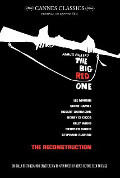
Directed by
Samuel Fuller
158 minutes
Rated M
Reviewed by
Bernard Hemingway

The Big Red One
Synopsis: The Big Red One is the nick-name of the First U.S. Infantry Division. We follow Sergeant Savage (Lee Marvin), and four soldiers, Griff (Mark Hamill), Vinci (Bobby Di Cicco), Johnson (Kelly Ward) and Zab (Robert Carradine) as they fight in the Second World War between 1942 and 1945.Sam Fuller's final film is a remarkable one. Originally released in 1980, drastically abridged by 50 minutes, we now have the opportunity see what is pretty close to Fuller's original film although it still lacks a couple of scenes and critic and filmmaker, Richard Schickel, who was responsible for the restoration has included an intermittent voice-over and titles identifying the location and dates of the various theatres of war in which Sgt. Savage and his men fight, elements which Fuller apparently did not want.
Based on the director's own experiences in World War II. The Big Red One is unusual in the annals of war films in that there is little in the way of dramatic interaction between the players. Fuller's principal goal is to bring the audience as close as possible to the reality of war and much less with narrative development. Hence the episodic nature of the film, something which facilitated the original excision of the more controversial scenes such as that in which the rookie infantry soldier has his testicles blown off and that in which a baby is born in an abandoned tank. On the other hand we get marvellous in-our-face action with the camera very close to proceedings and a sound design that has the theatre positively shaking as tanks rumble across the screen, or in one scene the sound of empty shells hitting the ground as Griff empties his clip into a German soldier.
Whilst there is on the one hand this kind of commitment to day-to-day realism, Fuller's film also operates on a symbolic level and is less about a group of actual soldiers than war as a generic experience. Hence the improbable journey of Sergeant Savage and his men from Algeria to Czechoslovakia's Falkenau death camp crematoria and the presence of the Nazi Sergeant Schroeder (Siegfried Rauch) as Savage's combative doppelganger. This mix of the epic and mundane make for a fascinating journey, particularly as Fuller does not use the film to beat his breast about the insanity or heroism of war although both of these poles are represented. What makes The Big Red One a significant presence amongst war films is that it encompasses so much but in such a matter-of-fact way. That Fuller nursed this project for 30 years is a testament to its importance to him and this reconstructed version is a vindication of his effort. The incomparable Lee Marvin (in a role that was at one time ear-marked for John Wayne) has been deservedly praised for his role in making this film as compelling as it is.
Unfortunately the ending of The Big Red One is a little unsatisfying, not because of its overtly symbolic function so much as because it is handled in such a conventional and perfunctory way. Whatever the real reasons for this it seems as if here Fuller's vision was wanting. For anyone interested in the war genre however, Fuller's film is essential viewing.
FYI: For those interested in such things Fuller appears as the combat photographer, whilst his wife Christa plays the disgruntled aristocrat whose castle Sgt. Schroeder is booby-trapping.

Want more about this film?


Want something different?




